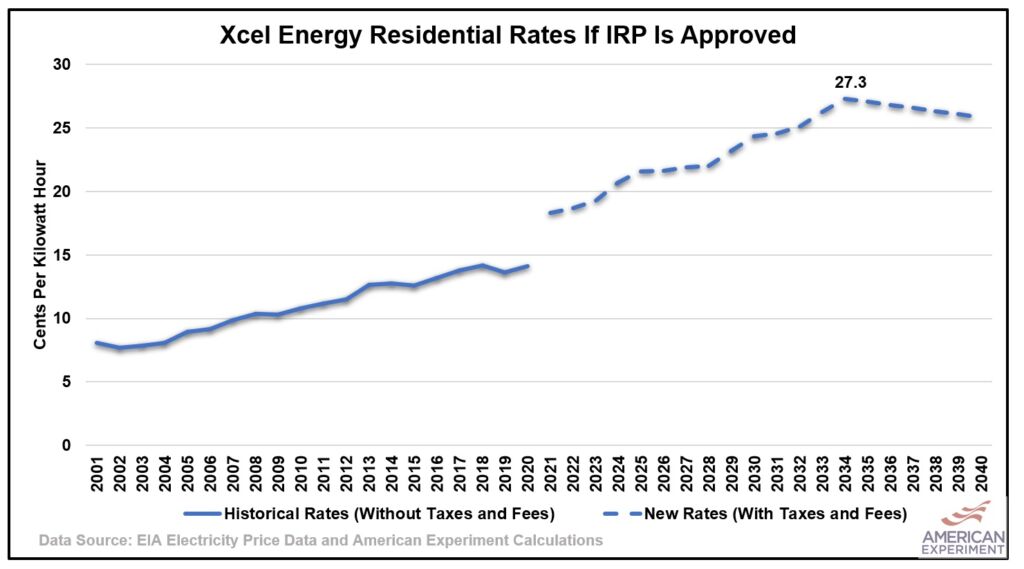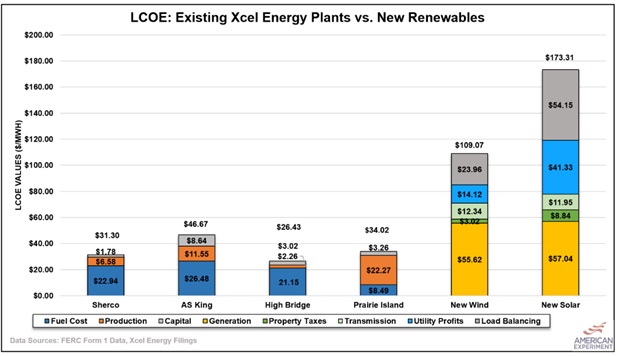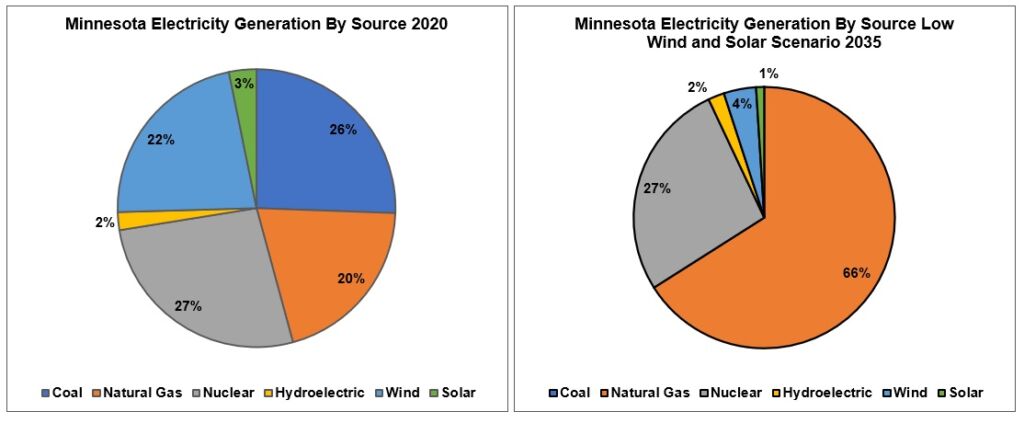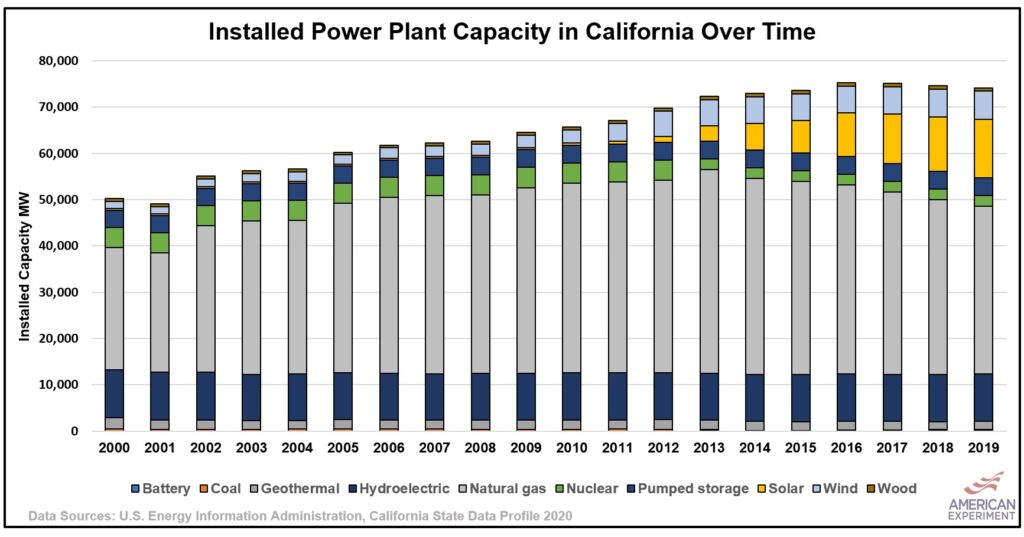American Experiment submits 60 pages of comments opposing Xcel Energy’s Green New Deal
Center of the American Experiment is proud to announce that earlier this year, our organization filed 60 pages of comments opposing Xcel Energy’s Green New Deal with the Minnesota Public Utilities Commission.
Xcel’s plan would retire their reliable, affordable coal plants a decade before the end of their useful lives and replace them with expensive and unreliable wind, solar, with natural gas backup.
This plan will come at huge costs to Minnesota families and businesses, make our state more susceptible to huge spikes in natural gas prices, and increase the risk of blackouts: all to potentially increase temperatures in Minnesota.
Costs for consumers
Our analysis shows that Xcel’s plan would cost Minnesota families and businesses an additional $57 billion through 2050, compared to what they are paying for electricity today. This translates into an additional $1,400 per year for every Xcel Energy customer (residential, commercial and industrial) through 2051.
Under Xcel’s plan, electricity prices for residential customers would nearly double, increasing to 27.3 cents per kilowatt-hour, by 2034. This means Xcel Energy customers will pay more for electricity than people who currently live in California, who pay 22.53 cents per kilowatt-hour.

Prices rise because Xcel Energy’s coal plants are some of the most affordable, and reliable producers of electricity in the state, and closing them down means we will be building unreliable wind turbines and solar panels that require expensive backup plants to try to keep the lights on.
The graph below shows the Sherburne County coal plant produced electricity for about $31 per megawatt-hour (MWh) in 2019. AS King, which was recently upgraded, produced electricity for $46.67 per MWh.

We calculated the cost of new wind and solar facilities by using Xcel’s assumptions for the generation cost, and then calculating the cost of increasing property taxes, transmission costs, utility profits, and the cost “load balancing,” which is the additional cost we pay for the “backup” natural gas facilities that must be on line to provide reliable electricity service.
When these hidden costs are accounted for, new wind facilities cost $109 per MWh and solar facilities cost $173 per MWh.
Natural gas price spikes
By prematurely retiring their coal plants in Minnesota, Xcel Energy is making our entire energy system more dependent upon wind, solar, and most importantly, natural gas, than ever before. This ended very poorly in Texas.
Cold-weather events like the Polar Vortex often cause wind turbines to produce very low amounts of electricity. This occurs because wind turbines automatically shut down when it is -22°F and because these weather events are often accompanied by low-pressure weather systems that produce little wind.
This means that once the coal plants are gone, natural gas will do the heavy lifting during extreme cold weather events if wind and solar don’t show up to work. The graph below shows what this might look like on a hypothetical day in 2035 with low wind and solar output.

Putting all of our electricity eggs in the natural gas basket will make large price spikes for home heating, like the extra $400 reported in February, more likely to occur because we will be depending on natural gas to heat our homes and power our electric grid. Unlike coal and nuclear plants, which store weeks or months of fuel on-site, natural gas arrives just-in-time by pipeline. This makes supplies more susceptible to bottlenecks and shortages.
Reducing reliability
Xcel’s plan would make Minnesota increasingly reliant upon the wind, solar, natural gas, and imports of electricity from other states when the wind isn’t blowing or the sun isn’t shining. This is the California model of energy policy, and it resulted in rolling blackouts last summer because other states didn’t have enough electricity to spare.
The graph below shows California had more power plants in service than ever before in 2019, but the amount of reliable capacity has been falling since 2013. Unreliable solar panels have made up the bulk of capacity additions since then, and solar panels don’t work at night.

Xcel is essentially doing the same thing by growing the amount of wind and solar on the grid and shutting down its coal plants, which is bad news for all Minnesotans.
Increasing local temperatures
Xcel’s entire justification for this plan is to reduce carbon dioxide emissions, but reducing these emissions will reduce future temperatures by 0.00039° C by 2100, an amount far too small to measure. However, research from Harvard suggests Xcel’s plan would result in a massive increase in local temperatures caused by wind turbines mixing air columns in the atmosphere.
Temperature observations at a wind facility in Texas show significant warming, especially at night. This local surface warming would dwarf the reduction in future temperatures from Xcel Energy’s plan.

By building out a fleet of wind turbines, Minnesotans would get the worst of all worlds: higher costs for electricity and warmer local temperatures near the earth’s surface, which has important implications for the state’s agricultural industry.
Many of these points are discussed in greater detail in our official comments. American Experiment will also be supplementing these comments with additional information to protect Minnesota families and businesses from rising costs.